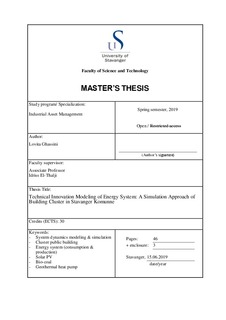| dc.description.abstract | System Dynamics is a program approach to understand the system by analysing and designing with the multiloop and time-lag characteristic and program that been used in this thesis called Vensim PLE. The system dynamics model has been used to analyse the trend of the energy consumption and energy production of a case study in a cluster of the public building in an area in Stavanger city, Norway. The group of the building consists of four buildings that are the kindergarten, the sports hall, the town hall, and the school. Several factors influenced the energy consumption such as the activity of the building, the building condition, the design of the building, and the seasonal effect. The energy consumptions are getting increased as the time goes by as well as the greenhouse gas emission. Renewable energy is one the greatest solution for the energy source to quit fossil fuel. Therefore, the government of the country must have some approach to minimize the energy consumption and technical solution for reducing greenhouse emission gas.
This thesis intends to continue the previous study by improving the scope of the study. The previous relevant researches have a different focus, i.e., focus on the general condition of the town, the office buildings, a district in the city, and an office and a residential building. Whereas, this study concentrates on more than one structure of the few public building in the area of the city.
This thesis aim is to explain and predict the dynamic behaviour of the building energy system in a group of building with the involvement of understanding the solution to reduce greenhouse emission gas. The study conduct by simulating the system dynamic model of the relation between energy production and energy consumption. The relationship of both creates the balancing loop diagram, and the result of the model were examined according to the utilization pattern.
The methodology of the thesis has been done in three main stages that are (i) obtained the energy production data from the solar PV arrangement from the HelioScope program by managing the most optimum design from the tilt angle, type of racking, azimuth angle, and row spacing, (ii) organizing of each building energy consumption by hourly, seasonally and yearly, (iii) both of the energy production and the energy consumption has been computed in Vensim PLE program to analyse the dynamic behaviour.
The result from system dynamics modeling illustrates that the system establishes two balancing causal loop diagram, the main loop is the energy production and the energy consumption with several parameters that influence the system that are utilization factor, seasonal factor, holiday factor, and solar output. The other balancing loop is the presence of battery storage between energy production and energy consumption.
The seasonal factor is the essential key as a determinant of the amount of solar PV yield and the fluctuation of the energy consumption utilization pattern. When in summer time the energy production reaches its peak due to the appearance of the sun, while the energy usage was on minimum value since it does not need much electricity. In comparison, when in winter, the condition was reversed, the solar PV output was difficult to generate energy, and the electricity was on maximum utilization. Hence, in the middle of the year, energy production might remarkably cover energy consumption. Several technical solutions could be done to improve solar PV production and minimize energy usage. To maximize the ability of the solar PV to receive the solar radiation can be by designing the appropriate roof and managing the optimum parameter arrangement of the solar PV module. For instance, the design of the roof should be tilted facing the sun, build the standalone PV panel grid, use the battery storage to keep the energy, and many other solutions. To minimize the energy usage might be done by managing the ventilation, the heater position, reduce the activity of the building or reduce the student of the kindergarten and school.
The condition of the utilization profile for the four buildings has been analysed, and the electricity consumption peaks were classified according to the weekdays peak, weekend peak, and weekend or holidays. The organized summary of average in monthly was computed into the system dynamics program, and then the graph output has been used to explain the condition of the energy behaviour and prediction of the future pattern of the system. The graph illustrates that there is a utilization shift between the building that occurs due to this study focus on four buildings instead of 1 building, and they have a different activity and different holiday time.
The implication of this study is to support the city government to reduce greenhouse emission and reduce electricity consumption by converting the electric heater to the hydronic heater. The source of the electric heater is come from the electricity grid, while the hydronic heater is by using the water as the medium and the renewable energy for the source of energy. The energy sources considered for the hydronic heater are the bio-coal and geothermal heat pump. The concept of the bio-coal as the energy source for the hydronic heater is to use the bio-coal as a solid fuel to process the water boiler or to burn the furnace; while, the geothermal heat pump is by using the energy from the ground. Both of them has the ability to reduce greenhouse gas, yet the bio-coal has more benefit and less effort than the geothermal heat pump. | nb_NO |
